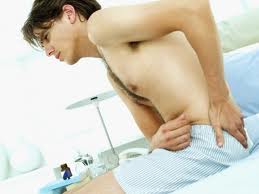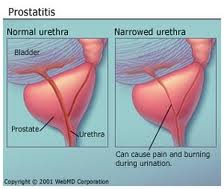Any infection or inflammation can cause the prostate gland to swell, squeezing the urethra and affecting the ability to urinate. That’s exactly what happens in prostatitis, although the cause of the inflammation depends on the type of prostatitis.

Types
There are four types of prostatitis: Acute bacterial prostatitis, chronic bacterial prostatitis, nonbacterial prostatitis, and prostatodynia.
Acute bacterial prostatitis (ABP) is inflammation of the prostate gland caused by bacteria such as Escherichia coli and Klebsiella. Severe complications may develop if not promptly treated. ABP can be fatal if the bacterial infection is untreated and travels to the bloodstream (sepsis).
Chronic bacterial prostatitis (CBP) is a recurrent infection and inflammation of the prostate and urinary tract. Symptoms are less severe than those associated with acute bacterial prostatitis.
Nonbacterial prostatitis is an inflamed prostate without bacterial infection.
Prostatodynia, sometimes called chronic pelvic pain syndrome (CPPS), is the occurrence of prostatitis symptoms, without inflammation or bacterial infection.
Causes
Risk factors include bladder outlet obstruction (e.g., stone, tumor, BPH), diabetes mellitus, a suppressed immune system, and urethral catheterization (i.e., small tube inserted into the bladder through the urethra to drain urine). Some sexually transmitted diseases (STDs; e.g., non-gonnococcal urethritis, gonorrhea) increase the risk for developing bacterial prostatitis.
Acute Bacterial Prostatitis:
Bacterial prostatitis is caused by the growth of bacteria that are normally found in prostatic fluid, such as Escherichia coli and Klebsiella. Approximately 80% of organisms causing ABP are aerobic gram-negative organisms (e.g., Escherichia coli, Enterobacter, Serratia, Pseudomonas, Enterococcus, and Proteus species). Urine that flows back into the urethra (urine reflux) that enters the prostate can also cause the condition.
Chronic bacterial prostatitis :
Sometimes bacteria remain in the prostate following acute prostatitis. Catheter tubes used to drain the urinary bladder, trauma to the urinary system or infections in other parts of the body can sometimes be the source of the bacteria.
Chronic nonbacterial prostatitis:
1) Heavy lifting: Lifting heavy objects when the bladder is full may cause urine to back up into the prostate.
2) Certain occupations: Occupations that subject the prostate to strong vibrations, such as driving a truck or operating heavy machinery, may play a role. Though biking is a good exercise for the rest of the body, it may irritate the prostate gland.
3) Structural abnormalities of the urinary tract: Narrowing (stricture) of the urethra may elevate pressure during urination and cause symptoms. Sometimes prostatitis is caused by a sexually transmitted organism, such as Chlamydia. However, most cases are caused by infections that are not sexually ransmitted. These infections can’t be passed on to sexual partners.
Symptoms
The acute form of prostatitis is the least common, but is also the most severe. Symptoms are often sudden, and the condition may require hospitalization. Symptoms of chronic prostatitis tend to develop more slowly and aren’t as severe as those of acute prostatitis
Symptoms of acute bacterial prostatitis (ABP) include the following:
- Fever
- Chills
- Frequent urination
- Painful urination (dysuria)
- Incomplete emptying of bladder
- Sensation of having to urinate immediately, often accompanied by bladder pain or spasm (urgency)
- Pain in penis, testicles, and area between the scrotum and the rectum (perineum)
- Painful ejaculation
- Lower back pain
- Joint pain (arthralgia)
- Muscle pain (myalgia)
- Tender, swollen prostate
Symptoms of chronic bacterial prostatitis (CBP) and nonbacterial prostatitis are generally less severe than those of ABP and include the following:
- Blood in semen (hematospermia)
- Discomfort in genital area and Perineum
- Dysuria: Pain or a burning sensation when urinating
- Fever
- Lower back pain
- Pain in lower abdomen
- Painful ejaculation
- Recurring urinary tract infection (UTI)
- A frequent and urgent need to urinate
- Pain in the prostate
- Excessive urination during the night (nocturia)
Chronic nonbacterial prostatitis is the most common form, yet it’s also the least well understood. Researchers aren’t even sure of the cause.
In general, the signs and symptoms of nonbacterial prostatitis are similar to those of chronic bacterial prostatitis, although fever is generally absent. The major difference, however, is that tests won’t detect any bacteria in the urine or in fluid from the prostate gland. But there may be white blood cells in the urine and semen.





